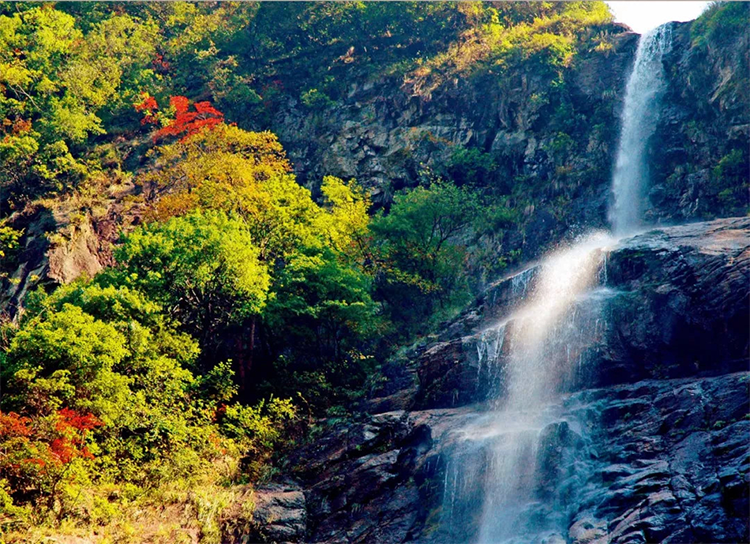Mingyue Mountain’s Qingyun Glass Walkway: Hot Springs, Sea of Clouds & Zen Hiking
When mist drapes the subtropical forest across steep cliffs and a 119-meter waterfall plays a granite symphony, you begin to understand why poets likened Mingyue Mountain to a “crescent fallen to earth.” This crescent-shaped range near Yichun in Jiangxi Province preserves one of the most complete primitive ecosystems at this latitude and blends adrenaline-filled cliff walks, healing selenium hot springs, and millennia of Chan (Zen) heritage into a singular ecological wonder along the 27°N parallel.
1. Geological Wonders and an Ecological Treasure
Taiping Peak (Taiping Shan), at 1,735.6 meters, is the best vantage for Mingyue Mountain’s signature “sea of clouds.” With more than 200 foggy days a year, rolling clouds sometimes turn the range of 36 peaks into islands in the sky. Serious hikers often start at 5:00 a.m. to catch the sunrise spectacle of “Buddha’s light” and rainbows. The 136-square-kilometer primary forest supports over 2,000 plant species, including the southern yew, and shelters rare birds such as the scaly-sided merganser (Chinese merganser).
The most heart-racing attraction is the Qingyun Glass Walkway. Hung along a 1,600-meter cliff, this transparent corridor wraps the nearly vertical rock like a ribbon. Walking the translucent path, you look down into a dizzying abyss and out across a roiling cloud sea—an intoxicating mix of adrenaline and ink-wash scenery. Wear grippy hiking shoes; on clear days this is when the poetic feeling of “not daring to speak loudly, lest you startle the people above” is most palpable.

2. Millennia of Cultural Imprint
Northern Song literary master Huang Tingjian recorded “a jade spring within Mingyue Mountain,” and the study site of Southern Song Neo-Confucian scholar Zhu Xi—the “Zhuzi Study Platform”—is still visitable. At about 800 meters elevation, Yangshan Xiyin Chan Temple houses the core of Chan practice: it is known as an origin site of the Wei-Yang Chan lineage and preserves a ginkgo tree said to have been planted by Tang dynasty master Huiji. In autumn, the golden carpet of ginkgo leaves is a photographic treasure.
Wentang Town’s selenium-rich hot springs have been documented since the Southern Song (Chunxi era, 1174). Constant 68–72°C springs contain some 27 minerals. Locals still keep the tradition of wooden-tub soaks, and Ming and Qing-style hot spring wells in town still steam year-round. The annual Mid-Autumn Moon Culture Festival combines a moon-worship ceremony and a hot-spring lantern fair, offering a vivid local folk experience.

3. Year-Round Activities and Best Seasons
– Spring (March–May): Rhododendron blooms paint hills crimson; cloud valleys and waterfalls swell. Bring waterproof gear to try canyoning near the falls.
– Summer (June–August): Moon Lake at 1,500 meters is a cool retreat (night temperatures around 18°C). Starry-night camping often reveals fireflies and a bright Milky Way.
– Autumn (September–November): Temple ginkgo and maple leaves form golden corridors—ideal for photography and Zen-themed shoots. The onsen season for wellness begins.
– Winter (December–February): Rime on Taiping Peak creates crystal scenes, and a beginner-friendly ski area sits atop the mountain. Combine skiing with a post-ride hot spring for a perfect day.

4. Practical Travel Tips
The park is a 30-minute drive from Yichun High-Speed Rail Station to the east gate. Buy a combined ticket that includes the shuttle bus, cable car, and hot springs (around ¥280). A classic route: take the cable car to mid-station → hike the Qingyun Glass Walkway → summit Taiping Peak → descend for a hot-spring soak. Plan 6–8 hours for the full loop; less fit visitors can use the direct summit cable car.
Mingyue Mountain Holiday Hot Spring Hotel offers in-room selenium spring access, while guesthouses in Wentang Town provide private hot tubs for about ¥100 per person. Try the hot-spring wellness banquet—silky tofu cooked in selenium spring water is a local delicacy. English signage covers main attractions, but for deeper cultural insight we recommend booking a bilingual guide.
Designated by China National Geographic as one of Central China’s best ecological tourism destinations, Mingyue Mountain satisfies both thrill-seekers and those seeking restorative calm. Touch the cloud sea on the glass path, hear morning bells at a thousand-year-old Chan temple, and watch dusk settle from a selenium spring—then you will understand Li Bai’s yearning to “reach the heavens and pluck the moon.” Visit on a weekday if you can, and let Mingyue Mountain unfold its layered landscape for you.


